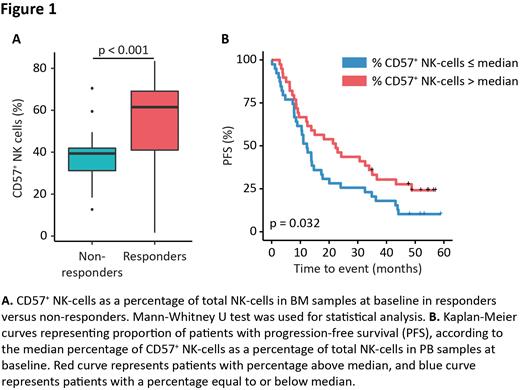Background
Non-fit multiple myeloma (MM) patients have inferior survival, increased toxicity, and higher rates of treatment discontinuation compared with their fit peers. Effective and less toxic treatment strategies are therefore urgently needed for this vulnerable population. The HOVON-143 trial (EudraCT: 2016-002600-90) was specifically designed to assess the efficacy and safety of daratumumab-ixazomib-dexamethasone in non-transplant eligible (NTE), intermediate fit and frail newly diagnosed (ND)MM patients. Patients were treated with nine 28-day induction cycles comprising daratumumab 16 mg/kg intravenously (cycles 1-2: days 1, 8, 15, and 22; cycles 3-6: days 1 and 15; cycles 7-9: day 1), ixazomib 4 mg orally (days 1, 8, and 15) and dexamethasone orally (only on days that daratumumab was given; cycle 1-2: 20 mg; cycle 3-9: 10 mg), followed by 8-week maintenance cycles consisting of daratumumab (day 1) and ixazomib (days 1, 8, 15, 29, 36, 43) for two years or until disease progression.
Aims
Since daratumumab has well-known NK-cell-mediated effector mechanisms and T-cell-stimulating immunomodulatory effects, we monitored these cell subsets in bone marrow (BM) and peripheral blood (PB) samples obtained before and during treatment. We specifically aimed to better understand these cell subsets related to frailty status, their predictive value for treatment outcome, and their dynamics during treatment.
Methods
126 NDMM patients, among which 64 intermediate fit and 62 frail, were monitored. BM was collected at study-entry (baseline) and at disease progression; PB was collected at baseline, before cycle 4, before maintenance, and at disease progression. Absolute numbers of total T-cells and NK-cells (in PB) or percentages of T-cell and NK-cell subsets (in PB and BM) were profiled by flow cytometry. Data were analyzed using FlowSOM and UMAP. Total cells and cell subsets at baseline were compared between intermediate fit and frail patients, between responders (≥ partial response) and non-responders (< partial response), and associated with progression-free survival (PFS) and overall survival (OS).
Results
At baseline, we found no difference in absolute numbers of total T-cells and NK-cells between intermediate fit and frail patients. Besides, NK-cell phenotype was similar between both groups. However, within the T-cell compartment frail patients had a decreased CD4 +:CD8 + T-cell ratio, reduced naïve CD4 + and CD8 + T cells, and increased PD1 + CD4 + T-cells compared with intermediate fit patients in both BM and PB, independent of age. Interestingly, differences in T-cell phenotype were more pronounced in female than in male patients.
Response data were available for 124 patients, of which 92 (74%) responded to treatment. In both BM and PB, preliminary results showed no clear association between response and absolute numbers of total T-cells or certain T-cell phenotypes at baseline. However, responders had higher absolute numbers of total NK-cells and higher percentages of NK-cells positive for maturation marker CD57 or fc-gamma receptor CD16 than non-responders, while higher absolute numbers of total NK-cells and higher percentages of CD57 + NK-cells were also associated with superior PFS and OS (Figure 1). Conversely, higher proportions of baseline NK-cells positive for inhibitory markers TIGIT and PD1 were associated with non-response, while higher percentages of CD56 bright and PD1 + NK-cells were negatively associated with PFS and OS.
As expected, absolute numbers of total NK-cells markedly declined during the treatment course. Interestingly, percentages of CD57 + and CD16 + NK-cells decreased during treatment and remained low at disease progression, while percentages of CD56 bright and NKG2A + NK-cells substantially increased compared with baseline.
Conclusions
Frail patients had a distinct T-cell profile compared with intermediate fit patients, while NK-cell profiles were similar. Treatment outcome of NTE-NDMM patients treated with daratumumab-ixazomib-dexamethasone was positively associated with higher absolute numbers of total NK-cells and higher percentages of CD57 + and CD16 + NK-cells at baseline, corresponding to a mature and cytotoxic phenotype capable of mediating potent antibody-dependent cellular cytotoxicity. This study highlights the importance of NK-cell phenotype for the effectivity of daratumumab-based combination therapies in NTE-NDMM.
Disclosures
van de Donk:Janssen Pharmaceuticals: Other: Advisory Board, Research Funding; Amgen: Other: Advisory Board, Research Funding; Celgene: Other: Advisory Board, Research Funding; Novartis: Other: Advisory Board, Research Funding; Cellectis: Research Funding; BMS: Other: Advisory Board, Research Funding; Takeda: Other: Advisory Board; Roche: Other: Advisory Board; Bayer: Other: Advisory Board; Pfizer: Other: Advisory Board; Abbvie: Other: Advisory Board; Adaptive: Other: Advisory Board; Servier: Other: Advisory Board. Zweegman:Oncopeptides: Membership on an entity's Board of Directors or advisory committees; Sanofi: Membership on an entity's Board of Directors or advisory committees; Takeda: Membership on an entity's Board of Directors or advisory committees, Research Funding; BMS: Membership on an entity's Board of Directors or advisory committees; Janssen: Membership on an entity's Board of Directors or advisory committees, Research Funding; Celgene: Research Funding. Mutis:Genmab: Research Funding; Janssen: Research Funding; Takeda: Research Funding.


This feature is available to Subscribers Only
Sign In or Create an Account Close Modal